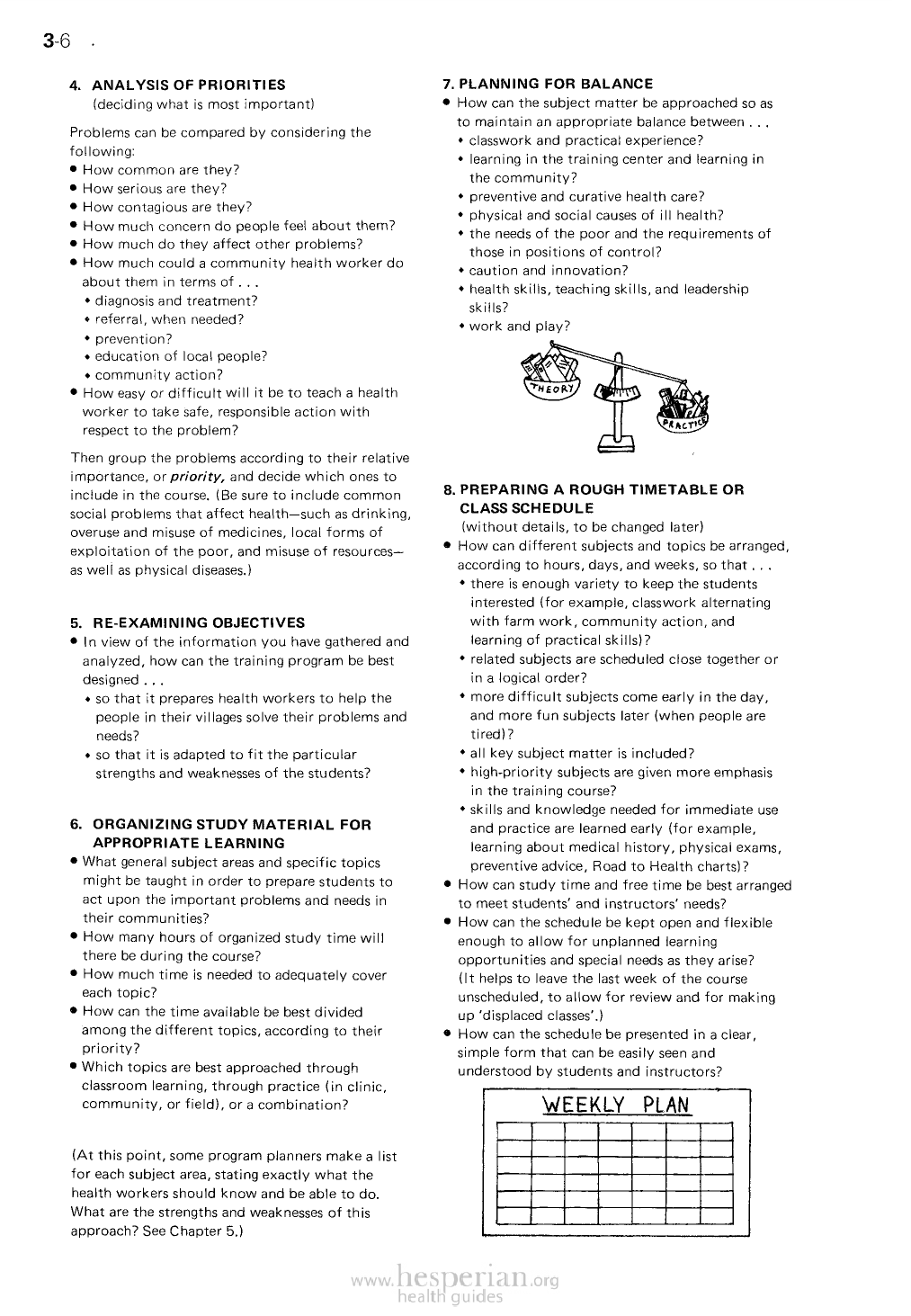
3-6
4. ANALYSIS OF PRIORITIES
(deciding what is most important)
Problems can be compared by considering the
following:
• How common are they?
• How serious are they?
• How contagious are they?
•
•
How
How
much
much
concern do people feel about them?
do they affect other problems?
• How much could a community health worker do
about them in terms of . . .
♦♦ diagnosis and treatment?
♦♦ referral, when needed?
♦♦ prevention?
♦♦ education of local people?
♦♦ community action?
• How easy or difficult will it be to teach a health
worker to take safe, responsible action with respect
to the problem?
Then group the problems according to their relative
importance, or priority, and decide which ones to
include in the course. (Be sure to include common
social problems that affect health—such as drinking,
overuse and misuse of medicines, local forms of
exploitation of the poor, and misuse of resources—as
well as physical diseases.)
5. RE-EXAMINING OBJECTIVES
• In view of the information you have gathered and
analyzed, how can the training program be best
designed . . .
♦♦ so that it prepares health workers to help the
people in their villages solve their problems and
needs?
♦♦ so that it is adapted to fit the particular strengths
and weaknesses of the students?
6. ORGANIZING STUDY MATERIAL FOR
APPROPRIATE LEARNING
• What general subject areas and specific topics
might be taught in order to prepare students to act
upon the important problems and needs in their
communities?
• How many hours of organized study time will there
be during the course?
• How much time is needed to adequately cover
each topic?
• How can the time available be best divided
among the different topics, according to their
priority?
• Which topics are best approached through
classroom learning, through practice (in clinic,
community, or field), or a combination?
7. PLANNING FOR BALANCE
• How can the subject matter be approached so as to
maintain an appropriate balance between . . .
♦♦ classwork and practical experience?
♦♦ learning in the training center and learning in the
community?
♦♦ preventive and curative health care?
♦♦ physical and social causes of ill health?
♦♦ the needs of the poor and the requirements of
those in positions of control?
♦♦ caution and innovation?
♦♦ health skills, teaching skills, and leadership
skills?
♦♦ work and play?`
8. PREPARING A ROUGH TIMETABLE OR
CLASS SCHEDULE
(without details, to be changed later)
• How can different subjects and topics be arranged,
according to hours, days, and weeks, so that . . .
♦♦ there is enough variety to keep the students
interested (for example, classwork alternating
with farm work, community action, and learning
of practical skills)?
♦♦ related subjects are scheduled close together or
in a logical order?
♦♦ more difficult subjects come early in the day,
and more fun subjects later (when people are
tired)?
♦♦ all key subject matter is included?
♦♦ high-priority subjects are given more emphasis
in the training course?
♦♦ skills and knowledge needed for immediate use
and practice are learned early (for example,
learning about medical history, physical exams,
preventive advice. Road to Health charts)?
• How can study time and free time be best arranged
to meet students’ and instructors’ needs?
• How can the schedule be kept open and
flexible enough to allow for unplanned learning
opportunities and special needs as they arise?
(It helps to leave the last week of the course
unscheduled, to allow for review and for making up
‘displaced classes’.)
• How can the schedule be presented in a clear,
simple form that can be easily seen and understood
by students and instructors?
(At this point, some program planners make a list
for each subject area, stating exactly what the
health workers should know and be able to do.
What are the strengths and weaknesses of this
approach? See Chapter 5.)